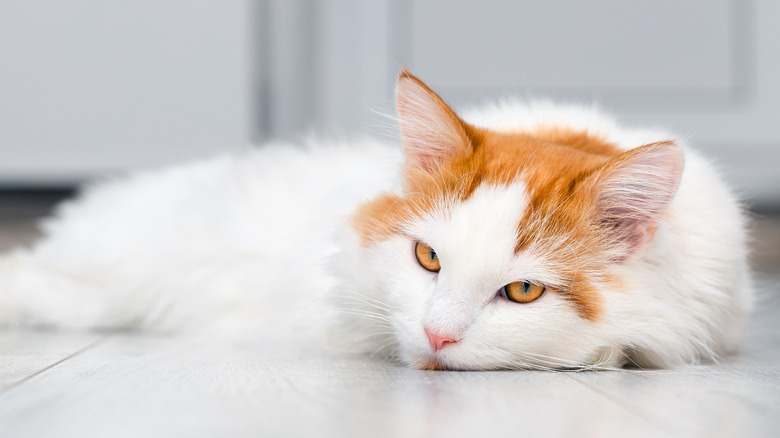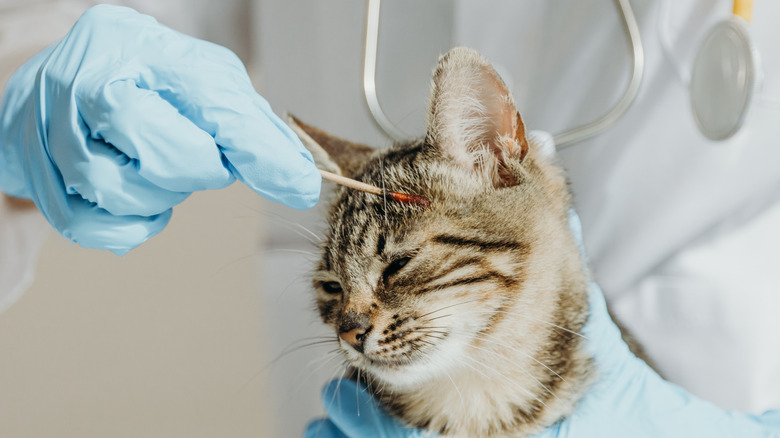If Your New Shelter Cat Gets Sick Right After Adoption, It Might Be 1 Of These Illnesses
Adopting a cat from a shelter can be an exciting, rewarding experience. Not only are you giving a pet a cozy, loving home; you're adding a new family member that will bring joy to your life. Unfortunately, the experience of adopting a cat sometimes comes with challenges that require extra patience and understanding on your end. Many cats exhibit certain symptoms after adoption as a result of a specific health condition. In some cases, the cat may have a known illness like ringworm before meeting its adopters. In others, factors in its new home, such as allergies following a food change, cause it.
The good news is that many conditions can be treated either by a veterinarian or at home and aren't life-threatening. However, it's important to ask the shelter employee to provide you with as much information as possible about the cat's health if you're concerned about future expenses or other wellness-related obligations. The goal of all animal shelters is for each pet in their care to find a forever home. With that in mind, it's best to make an informed adoption decision and be prepared for potential medical surprises.
Food allergies can affect newly adopted shelter cats
Cats can be allergic to food just like humans can. Upon adopting your new cat, the shelter employee will likely recommend feeding it the same food it ate at the shelter, at least at first. If you want to change the food later, it's best to transition gradually to prevent digestive upset. However, after introducing your cat to a new food, it might develop an allergy to a certain ingredient. Even if you choose not to change the food, it's still possible for it to develop a food allergy later down the road.
Food allergies in cats can result in external symptoms on their skin, internal (gastrointestinal) symptoms, or both. These include itchiness, hair loss, skin rash, skin infection, diarrhea, weight loss, and vomiting. If you notice any of these symptoms, schedule an appointment with your veterinarian, who will examine your pet and rule out other potential conditions before making an official food allergy diagnosis. Then, they will discuss treatment options such as diet changes or medications.
Upper respiratory infection can show up in adopted cats
Upper respiratory infections (URIs) are among the most common cat illnesses seen in shelters. These infections typically affect the nose, sinuses, mouth, and/or throat, resulting in sneezing, eye drainage, coughing, nasal congestion, and other symptoms. As a contagious illness, it can be spread from cat to cat directly or indirectly. Stress also plays a role in how URIs are spread. Stress can weaken a cat's immune system, making it more vulnerable to upper respiratory infections and other illnesses.
Whether it's from the streets to a shelter or from a shelter to a house, transitioning from one environment to another can be stressful for a cat. Even if the new environment consists of a large home with an abundance of comforts and enjoyable places to explore, the cat won't understand why it's being relocated. It won't enjoy being pulled from its comfort zone. In general, it could take a cat months to feel safe in a new space. If your chosen cat were to contract a URI on its last day at the shelter, it can take about a week after being adopted for it to start showing symptoms.
Many URIs resolve themselves at home without veterinary care, assuming they don't involve any severe symptoms. However, it's best to contact your veterinarian and let them provide their recommendations, which might include at-home care tips or a visit to their clinic for an exam and treatment.
Flea allergy dermatitis can make your shelter cat itchy
Unfortunately, many shelter cats have fleas either because many lived outside at one point or because the tiny critters jumped from one cat to another at the shelter. Even if you're lucky enough to adopt a cat that doesn't have fleas, it could still get them from its new environment: your home and yard. All it takes is one paw step outdoors or for a flea to hitch a ride on the sole of your shoe to put your new feline friend at risk for flea bites. If your cat is allergic to flea saliva, it could lead to intense itching, scratching, and other problems: This reaction is known as flea allergy dermatitis.
Your first line of defense against flea allergy dermatitis should be to eliminate the fleas and stop the reproduction cycle. Give your cat a flea preventive as soon as possible in the form of a topical, oral, or collar treatment. You should also thoroughly clean and vacuum your home, especially the bedding, and treat your yard, too. Your veterinarian can discuss additional treatments, such as corticosteroids and antibiotics for the skin. You may be able to supplement these treatments with home remedies for flea allergy dermatitis to provide a little extra relief as well.
Ringworm can easily spread from adopted cats to others
Ringworm is yet another contagious condition that shelter cats often fall victim to. It's a fungal disease that affects a cat's skin, fur, and claws, resulting in circular hair loss patches, crusty skin, distorted nails, hardening at the base of the nails, and other symptoms. Despite the name, this illness doesn't involve intestinal worms; all symptoms are external.
You might not have noticed any abnormalities in your cat's appearance the day you brought it home, but that doesn't mean your new pet isn't infected with ringworm. The incubation period between exposure and symptom development ranges from one to two weeks, or sometimes as long as three weeks.
Ringworm treatment typically involves topical or oral medication, which your veterinarian can prescribe. It's best to schedule a visit with them as soon as you notice symptoms, as they're unlikely to disappear on their own without proper treatment. Plus, unlike other feline illnesses, ringworm is a zoonotic disease, which means it can spread to humans and any other pets in your household.
Feline leukemia virus (FeLV) affects many shelter cats
Feline leukemia virus (FeLV) is similar to human immunodeficiency virus (HIV) in that they both affect the immune system, leaving the body susceptible to other illnesses. It's spread via close contact in the form of sharing bowls or litter boxes, grooming, or bite wounds. Kittens can also contract the virus from their mother if she's infected. Some shelters don't test cats for FeLV, so it's possible for employees to be unaware of a positive case of the virus before releasing a cat for adoption.
Some of the symptoms of FeLV include enlarged lymph nodes, weight loss, fever, and breathing difficulties, to name a few. In some cases, the virus can shorten a cat's lifespan, and sadly, no cure exists for FeLV, but veterinarians can use antibiotics to treat certain secondary infections associated with it. If your adopted cat tests positive for FeLV, you'll want to do everything you can to prevent these infections. Keep it inside and don't allow it to interact with other cats.
FeLV isn't an automatic death sentence. Many cats with the virus go on to live happy lives for several years after the diagnosis. Your veterinarian can give you more information about the prognosis and ways you can help your new pet have the best quality of life possible. While all of these illnesses are possibilities, taking the time to let your newly adopted cat relax, explore, and settle in, along with a vet visit to ensure a clean bill of health, can help the transition go smoothly.
Always consult your veterinarian before making changes to your pet's diet, exercise, or care. To find an accredited veterinarian in your area, you can search the American Animal Hospital Association's online database.





